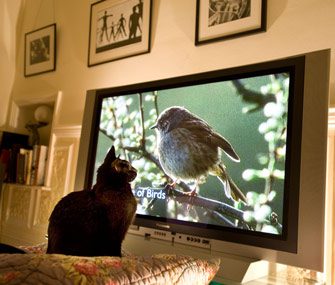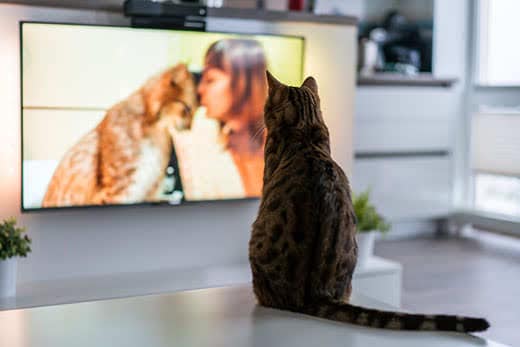
The cat is watching TV: what does she see
Cats consistently top the list of the most popular video characters on the internet, but can they enjoy watching videos themselves? Do cats see TV and are they able to keep the owner company while watching their favorite show?
Contents
How do cats see TV?
Many cats can and do watch TV, but “what they see on screen is not the same as what people see,” VetBabble veterinarians say. Pets are interested in colors and movement, and although cats are highly intelligent, they lack the cognitive and mental abilities that can be used to transform images and sounds into more complex thoughts.
Watching a fluttering red cardinal, the cat does not think: “What a beautiful red bird!” Rather, her thoughts are as follows: “Small object! Moving! To catch!”
Like humans, pets use their eyesight and hearing to watch TV. However, another reason why these animals are so attracted to the screens is that some of the videos awaken their innate hunting instincts.
Sensory responses in cats
When you watch TV, your eyes are the first thing to do. A cat’s ability to see the world begins with light hitting the retina. The two main types of photoreceptor cells in the retina, cones and rods, convert light into electronic signals. These electronic signals are transmitted to the brain, which allows cats to “see” the images in front of them.

As explained in the Merck Veterinary Manual, cones provide cats with sharp binocular vision and enable them to see different colors. Because they have fewer cones than humans, these pets cannot see the full spectrum of colors, but they can perceive red, green, and blue. At the same time, cats have more rods than humans, so their vision is much sharper than human, and in dim light – about six times better than their owners, reports Merck.
Because of this structure of the eyes, the animal will be more interested in the video sequence, in which there are fast moving objects in red, green and blue. For example, many TV shows for kids include primary colors and fast motion, so the furry viewer is more likely to enjoy watching children’s shows.
Hearing is one of the cat’s strongest senses, so it is also attracted to the sound coming from the TV. Being up to a meter away from a sound source, a cat can determine its location to within a few inches in just six hundredths of a second. Cats can also hear sounds at great distances—four or five times farther than humans. Thanks to its sharpest hearing, the pet pricks up its ears when hearing the sounds of nature on TV.
Behavioral responses
When a cat watches a red cardinal fluttering from branch to branch, instinct prompts him to catch the bird. With keen hearing, cats are able to determine the size and location of potential prey by the slightest movement, such as the rustle of a mouse in the grass. If in a TV show the cardinal flaps its wings and whistles through the branches, the pet will immediately go hunting.
Cats’ favorite prey are birds, small mammals, and fish, so they enjoy TV programs about any of these creatures.
Are cats able to watch TV without trying to ambush and attack what they see? Definitely. While some pets go crazy with what is happening on the screen, others can calmly watch what they see, and still others are not interested in the TV at all. Depending on the temperament and the strength of the hunting instinct, the cat may or may not perceive the TV or other electronic screens.

Some animals may show interest in kin programs, although scientists have not yet determined whether cats visually recognize their own kind or even themselves.
The sight of another cat on the screen will probably not awaken the hunting instinct in the pet, since, in addition to hearing, one of the cat’s strongest senses is the sense of smell. Pets have over 200 million olfactory receptors, compared to 5 million in humans. This gives them the ability to detect prey at great distances. But in most cases, even if the cat realizes that a similar creature is on the screen, it is unlikely to feel threatened, as in the case of a collision with a neighbor’s cat. The fact is that she will not be able to detect her smell or other signs that will tell her that this is a real cat, notes Cats Protection UK.
Until technological advances fill the television picture with smells, the pet will not react too aggressively to other cats on the screen.
Can cats watch TV
An influential 2008 study by the School of Psychology at Queen’s University Belfast looking at the reactions of shelter cats to visual stimulation produced interesting results on the topic of pets and television. Scientists have determined that XNUMXD screen time, especially videos with “images of prey and linear motion,” really enriches the cat’s environment.
This study also showed that for most four-legged friends, the interest in watching subsides only after three hours. Considering that cats are only active for about seven hours a day, this is a fairly long period of time, which scientists have compared to binge watching TV in humans.
Since this study, other cat behaviorists have incorporated video viewing into their pet mental stimulation programs. Researchers leading the Indoor Pet Initiative at the Ohio State University College of Veterinary Medicine have confirmed that watching videos of the movement of living creatures promotes the development of a cat’s hunting instinct. This is especially useful if she does not have free access to outdoor walks.
It’s easy to find TV programs designed specifically for cats. For example, there are special streaming services with video and audio materials designed specifically for pets. There are also many interactive cat game apps that can be downloaded to electronic devices.
The cat watches TV: does it calm him down
The Ohio State University College of Veterinary Medicine believes that if a cat is anxious, TV can have a calming effect in stressful situations. During thunderstorms or during high-profile construction work, the “white noise” of the screen can drown out unpleasant sounds for your pet. When family members are not at home, watching TV can also provide a furry friend with extra comfort and an enriching environment.
When using electronic stimulation, it is important to pay attention to the behavior of the pet. Being instinctive hunters, cats love to hit birds on the screen with their paws and catch cartoon squirrels. They may become frustrated not catching their e-prey, notes International Cat Care.
However, TV should not be the only source of entertainment for the cat. Screen time should be considered as a complement to other active ways to spend time together.
There is no substitute for a face-to-face contact with the owner of a furry friend. Finding the right balance between electronic stimulation and good old-fashioned pastimes like chasing soft toys filled with catnip or sitting on a kitty kit is desirable. From there, the cat will be able to watch wildlife through the window.
As more and more TV programs are created with cats in mind, owners and their furry friends have the perfect opportunity to have a good time in front of the TV, cuddled together. If the cat is watching TV, this is normal, and even better, do it together.





